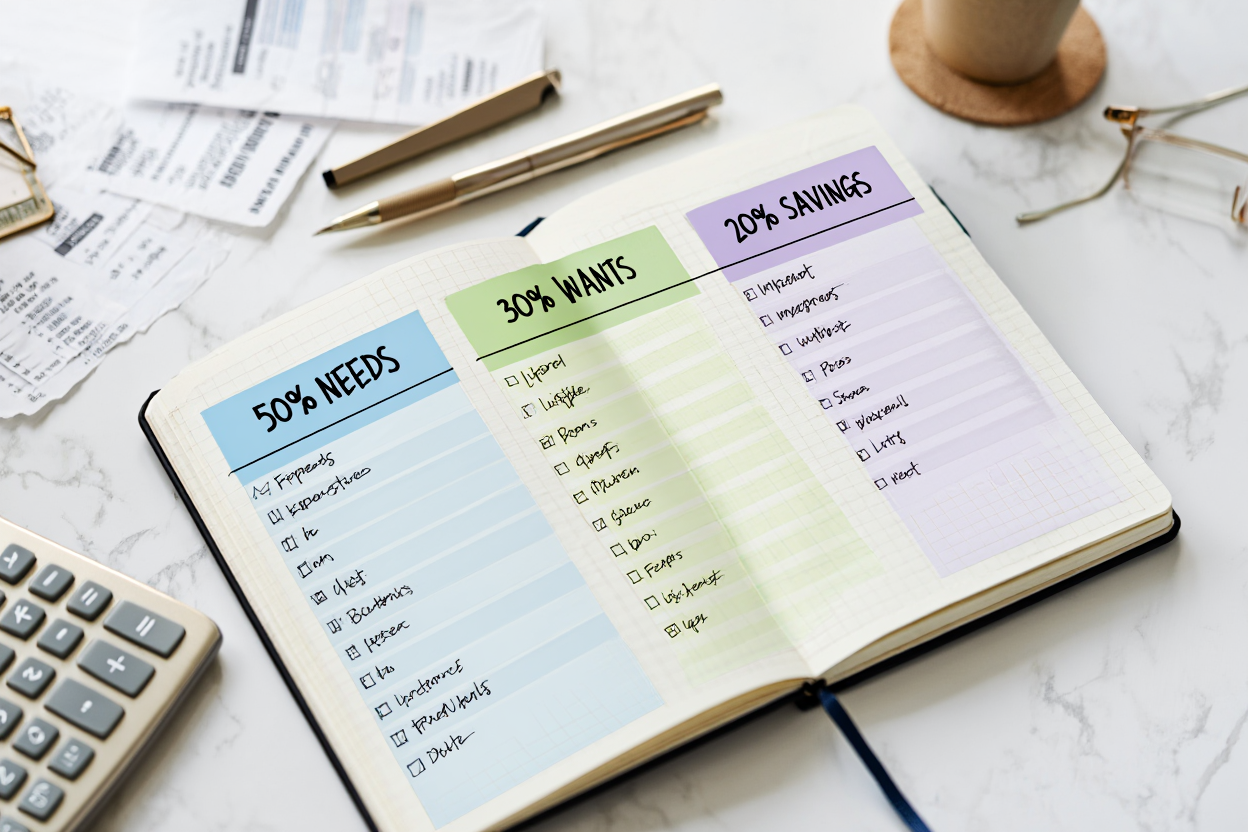
If you’ve ever searched for an easy, flexible way to manage your money, chances are you’ve come across the 50/30/20 rule. This popular budgeting method is praised for its simplicity, effectiveness, and adaptability to almost any financial situation.
But what exactly is the 50/30/20 rule, and how can you use it to take control of your finances?
In this comprehensive guide, we’ll break down everything you need to know — and by the end, you’ll feel confident enough to start using it today.
Quick Overview: What Is the 50/30/20 Rule?
The 50/30/20 rule is a budgeting guideline that helps you allocate your after-tax income into three major categories:
- 50% for Needs (essential living expenses)
- 30% for Wants (lifestyle and personal choices)
- 20% for Savings and Debt Repayment (future financial security)
It was popularized by Senator Elizabeth Warren in her book “All Your Worth: The Ultimate Lifetime Money Plan” and is widely used because of its clear, flexible structure.
Think of it as a financial blueprint that balances living in the present while planning for the future.
Why the 50/30/20 Rule Works
1. Simplicity
You don’t need complex spreadsheets, detailed expense tracking, or financial degrees to use this rule. Just categorize your expenses into three broad buckets.
2. Flexibility
Whether you earn $2,000 a month or $20,000, the 50/30/20 rule can adapt to your income level, lifestyle, and financial goals.
3. Focus on Priorities
It forces you to think about needs versus wants — a skill crucial for long-term financial success.
A Closer Look: Breaking Down the Categories
Let’s dive deeper into what fits into each section:
50%: Needs
Needs are your essentials — the expenses you absolutely must cover to live and work.
Examples of Needs:
- Rent or mortgage
- Utilities (electricity, water, gas)
- Groceries (basic food, not fancy dinners out)
- Health insurance
- Transportation (car payments, gas, public transit)
- Minimum loan payments
- Childcare
- Essential clothing
👉 If an expense can’t be avoided without major consequences, it falls into the Needs category.
Tip: If your needs exceed 50% of your income, you may need to consider downsizing or finding ways to lower essential costs.
30%: Wants
Wants are all about lifestyle upgrades and personal enjoyment — things you could technically live without.
Examples of Wants:
- Dining out and takeout
- Streaming services (Netflix, Spotify)
- Hobbies and leisure activities
- Vacations
- New electronics
- Gym memberships (unless medically necessary)
👉 Wants make life enjoyable, but they are optional. The 30% allocation helps you indulge — without letting spending spiral out of control.
Tip: If you have major savings goals (like buying a home), you might temporarily trim your wants to boost your 20% savings.
20%: Savings and Debt Repayment
This is your financial freedom bucket. It covers:
- Emergency fund contributions
- Retirement savings (401k, IRA)
- Investments (index funds, stocks)
- Paying off credit card debt faster than the minimum
- Saving for major goals (home down payment, education)
👉 The 20% allocation ensures you’re actively improving your net worth over time.
Tip: Always prioritize building an emergency fund (3–6 months of expenses) before investing heavily.
How to Start Using the 50/30/20 Rule
Ready to get started? Here’s a simple step-by-step process:
Step 1: Calculate Your After-Tax Income
This is the money you actually take home after taxes and deductions. Check your pay stub or bank deposits.
Example:
Salary: $4,000/month
Taxes and deductions: $800
After-tax income = $3,200
Step 2: Apply the 50/30/20 Split
Multiply your after-tax income by each percentage:
- Needs (50%) → $3,200 × 0.50 = $1,600
- Wants (30%) → $3,200 × 0.30 = $960
- Savings/Debt (20%) → $3,200 × 0.20 = $640
Step 3: Track and Adjust
Use a budgeting app, spreadsheet, or simple notes to monitor your spending over 1–2 months. Adjust if needed.
Infographic: The 50/30/20 Rule at a Glance
Here’s a visual summary you can save or print:
[Title: The 50/30/20 Budget Rule Simplified]
50% Needs:
🏠 Rent, groceries, health insurance, utilities, transportation
30% Wants:
🎉 Restaurants, subscriptions, shopping, entertainment, hobbies
20% Savings and Debt:
💰 Emergency fund, retirement, investments, extra debt payments
Real-Life Example
Let’s look at a sample budget for someone earning $3,200 after taxes:
| Category | Examples | Budget Limit |
|---|---|---|
| Needs | Rent ($800), groceries ($300), health insurance ($200), utilities ($150), transport ($150) | $1,600 |
| Wants | Dining out ($200), streaming services ($50), new clothes ($100), gym membership ($60), hobby supplies ($100), occasional travel ($450) | $960 |
| Savings & Debt | Retirement contributions ($400), emergency fund ($150), credit card extra payment ($90) | $640 |
✅ In this case, the person follows the 50/30/20 rule almost perfectly!
Common Mistakes to Avoid
Even with its simplicity, there are pitfalls to watch out for:
- Misclassifying Wants as Needs
- A new phone upgrade? That’s a want, not a need.
- Ignoring Irregular Expenses
- Annual insurance premiums or car maintenance costs should be planned for.
- Not Adjusting Over Time
- As your income, expenses, and goals change, revisit your 50/30/20 plan.
- Not Building an Emergency Fund
- Saving only for short-term goals without an emergency cushion can leave you vulnerable.
When the 50/30/20 Rule Might Not Fit Perfectly
While it’s a fantastic starting point, the 50/30/20 rule isn’t for everyone.
Consider adjusting if:
- You live in a high-cost-of-living area where housing eats up 50%+ alone.
- You have major debt and need to allocate more toward repayment.
- You are saving aggressively for a near-future goal (like buying a house in 1–2 years).
Alternative breakdowns like 60/20/20 (more for needs) or 70/20/10 (super-saving mode) are options too.
Tools to Help You Use the 50/30/20 Rule
- Budgeting Apps: Mint, YNAB (You Need a Budget), Simplifi
- Spreadsheets: Create a basic Excel or Google Sheets tracker
- Envelope Method: Physically split your money into three envelopes if you prefer cash
- Automated Transfers: Automatically set up savings and debt repayments
FAQs About the 50/30/20 Rule
Q: Should I count taxes in the 50/30/20 rule?
A: No. Always calculate based on your after-tax income.
Q: What if I have irregular income (like freelance work)?
A: Use your average monthly income over the last 6–12 months as your baseline.
Q: Is 20% savings enough?
A: It’s a great starting point. If you can save more — even better!
Final Thoughts: Is the 50/30/20 Rule Right for You?
The 50/30/20 rule is a fantastic budgeting method for beginners and pros alike. It’s easy, flexible, and teaches lifelong financial habits.
While it might need some tweaks depending on your situation, the core principle remains powerful: Balance your essentials, enjoy your life, and invest in your future.
Start with the 50/30/20 rule today — and watch your financial confidence grow!
“Do not save what is left after spending, but spend what is left after saving.” — Warren Buffett


